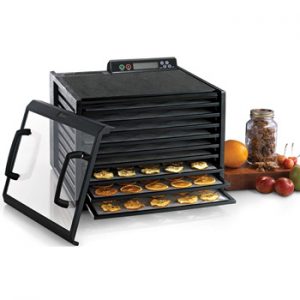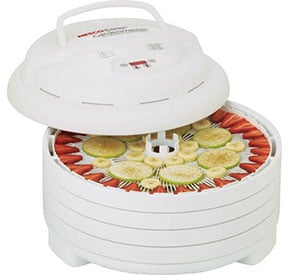
All of the food that comes in the summer has to be stored appropriately to be used for the entire year. Getting a food dehydrator can help you prepare food for storage as it dries them of water.
In our recent history, herbs were usually dried at home in attics and kitchens. You probably remember your grandma drying out linden on the kitchen table. The problem with this technique is that it requires a lot of space and the drying time is too long. Furthermore, if you live in an area with high humidity, you will have a difficult time drying out herbs without getting mildew and mold on them. That’s why a dehydrator is an excellent choice.
The Preparation
Like we mentioned before, drying herbs in a dehydrator is far easier and quicker than doing it the old fashion way.This machine can dry all of your herbs in three to four hours while air-drying them takes up to a month (depending on the climate where you live).
The dehydrator dries your herbs, all you have to do is take it out and store it in a glass or plastic jar. Dehydrators usually have 4 or 6 trays, and that lets you dry different herbs at the same time without the flavors mixing.
Make sure that you remove all of the surface moisture on the plants before putting them into the dehydrator. You can set small leaves with the stems inside, but make sure you clip them off when you’re done. If you want to dry roots, you will have to clean them and remove their outer layer. Then, slice each root to into smaller pieces (1/2 inches) and make sure they are all similar in size.
You will know that they are dried once they become hard and that usually takes up to ten hours. Roots typically have a strong aroma when drying so dry them in a garage or somewhere where the smell won’t bother you.

The Drying
The Storing

The enzymes found in dried herbs are concentrated, and they are four times as strong than in fresh herbs. The jars with herbs should be stored in a dark place and they should keep the contents fresh for as much as two years.
The enzymes found in dried herbs are concentrated, and they are four times as strong than in fresh herbs. The jars with herbs should be stored in a dark place and they should keep the contents fresh for as much as two years.

Conclusion
Dehydrators are a great device to have at home because they can turn your fresh food into dry food that has a much longer expiration date. Food dehydrators give you control and flexibility, so you know that you’ll have all the food you need even in the middle of the winter.
Drying herbs are the easiest of all food types. You can dry your entire garden in a couple of days so you’ll have all the spices and herbs for the next period. There are only a couple of things to remember: clean your herbs and cut them into similar pieces before putting them in the dehydrator. When they are done, put them in glass jars with tight lids, and you’ll be fine.













